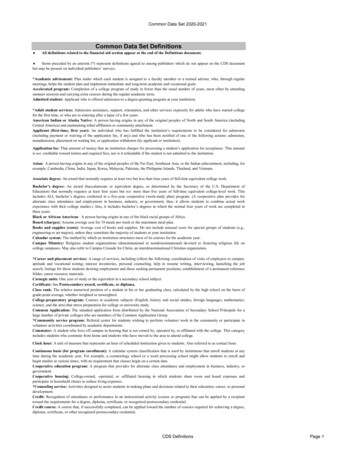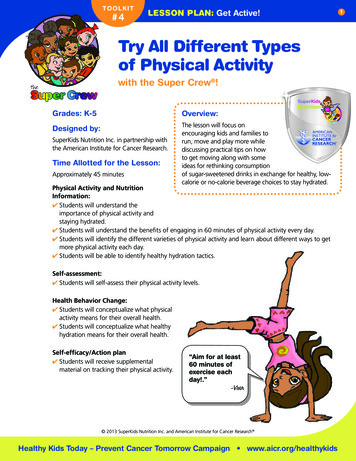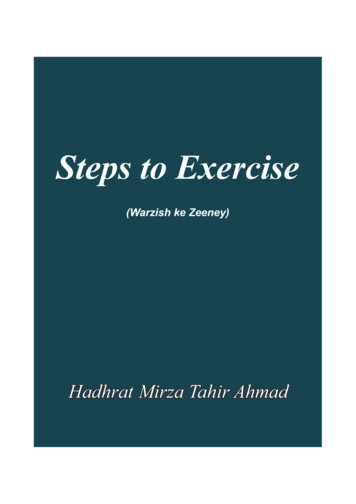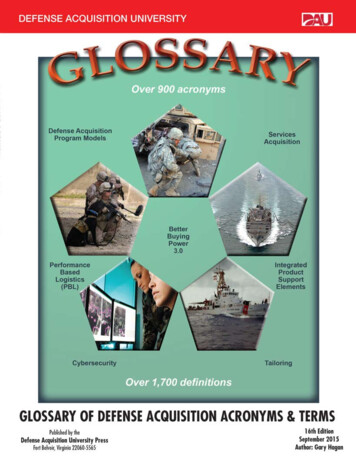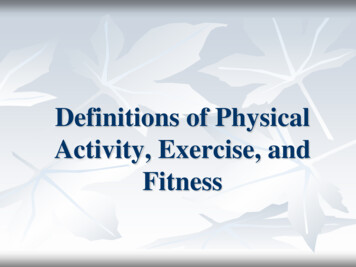
Transcription
Definitions of PhysicalActivity, Exercise, andFitness
Physical Activity The term “physical activity” describes manyforms of movement, including activities thatinvolve the large skeletal muscles.Activities that involve the small skeletalmuscles (e.g. playing board games, drawing,writing) are important, but they do not providethe health benefits of activities that involve thelarge skeletal muscles and require substantialenergy expenditure.
Physical activity is defined by itsduration, intensity, and frequency Duration is the amountof time spentparticipating in aphysical activity sessionIntensity is the rate ofenergy expenditureFrequency is thenumber of physicalactivity sessions duringa specific time period(e.g. one week).
Types of Physical ActivityAerobic - light to vigorous-intensity physicalAnaerobic – intense physical activity that isactivity that requires more oxygen than sedentarybehavior and thus promotes cardiovascularfitness and other health benefits (e.g., jumpingrope, biking, swimming, running; playing soccer,basketball, or volleyball).short in duration and requires a breakdown ofenergy sources in the absence of sufficientoxygen. Energy sources are replenished as anindividual recovers from the activity.Anaerobic activity (e.g., sprinting duringrunning, swimming, or biking) requiresmaximal performance during the brief period.Lifestyle – physical activity typically performed Physical activity play – play activity thaton a routine basis (e.g., walking, climbing stairs,mowing or raking the yard), which is usuallylight to moderate in intensity.requires substantial energy expenditure (e.g.,playing tag, jumping rope).Play – activity with flexible rules, usuallyself-selected, for the purpose of having fun.Sports – physical activity that involvesWeight-bearing – physical activity thatcompetition, scorekeeping, rules, and an outcome requires people to move their own weight.that cannot be predetermined. There are twocategories of sports: individual and team.
Exercise Exercise consists ofactivities that are plannedand structured, and thatmaintain or improve one ormore of the components ofphysical fitness.Physical activity suggests awide variety of activitiesthat promote health andwell-being.Exercise is often associatedwith fitness maintenance orimprovement only.
Types of ExerciseCalisthenics. Isotonic muscle-fitnessexercise that overloads muscles byforcing the muscles to work at ahigher level than usual.Flexibility (Stretching). Exercisedesigned to stretch muscles andtendons to increase joint flexibility orrange of motion. Specific flexibilityexercises need to be done for eachpart of the body.Isokinetic. Muscle-fitness exercise inwhich the amount of force equals theamount of resistance, so that nomovement occurs.Isotonic. Muscle-fitness exercise inwhich the amount of force exerted isconstant throughout the range ofmotion, including muscle shortening(concentric contractions), and musclelengthening (eccentric contractions).Muscle-fitness. Exercise designed tobuild muscle strength and enduranceby overloading the muscles; alsocalled progressive resistance exercise(PRE). Common forms of musclefitness exercise include isokinetic,isometric, and isotonic.
Fitness Participating in physical activity is beneficial topeople of all ages. Physical activity contributes tofitness, a state in which people’s health characteristicsand behaviors enhance the quality of their lives.
Types of FitnessPhysicalfitnessHealth-relatedphysical fitnessSkill-relatedphysical fitness A set of physicalattributes related to aperson’s ability toperform physicalactivity successfully,without undue strainand with a margin ofsafety. A physiological state ofwell-being that reduces therisk of hypokinetic disease;a basis for participation insports; and a vigor for thetasks of daily living.Components includecardio-respiratoryendurance, muscle strengthendurance, flexibility, andbody composition. Common components ofphysical fitness (e.g.,agility, balance,coordination, speed, power,reaction time) that enableparticipation in sports andother physical activities;also called performance ormotor fitness.
physical fitness Common components of physical fitness (e.g., agility, balance, coordination, speed, power, reaction time) that enable participation in sports and other physical activities; also called performance or motor fitness. Title: Definitions of Physical



